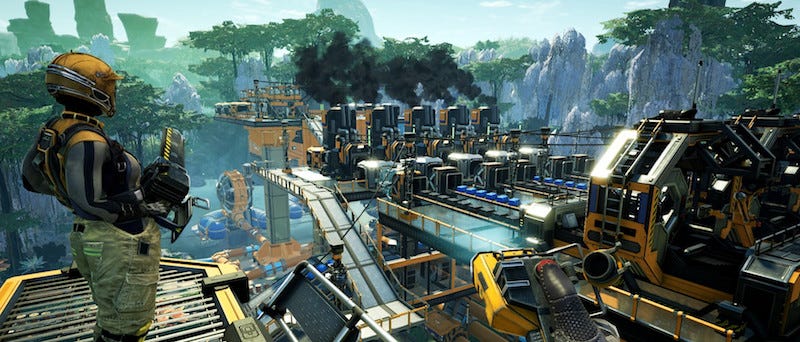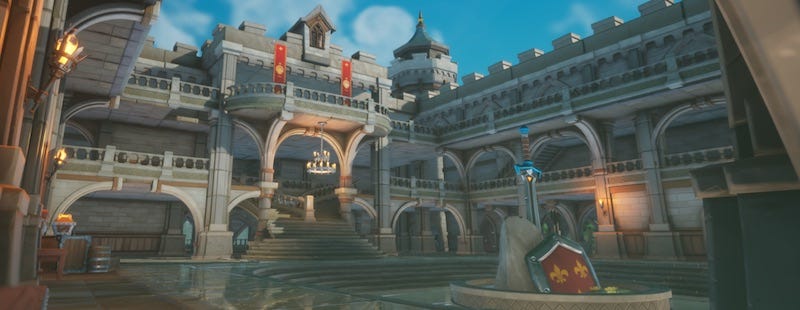Trending
Opinion: How will Project 2025 impact game developers?
The Heritage Foundation's manifesto for the possible next administration could do great harm to many, including large portions of the game development community.

Featured Blog | This community-written post highlights the best of what the game industry has to offer. Read more like it on the Game Developer Blogs or learn how to Submit Your Own Blog Post
Coffee Stain Studios were kind enough to go public with their game sales for standout first-person factory building game Satisfactory - what does that say about Epic Games Store and Steam?

[Hi, I’m ‘how people find your game’ expert Simon Carless, and you’re reading the Game Discoverability Now! newsletter, which you can subscribe to now, a regular look at how people discover and buy video games in the 2020s.]
Welcome to the latest Game Discoverabilityland round-up, a compendium of the week’s top news/links in the space. As happens a bit recently, I started this yesterday and ended up getting so deep into a subject that it’s become a standalone newsletter for next week (hah!)
So here’s the ‘real’ roundup newsletter, starting with… this:

The folks at Coffee Stain Studios were kind enough to go public with their game sales for standout first-person factory building game (think Factorio, but hella 3D!) Satisfactory, and yep, they’re good:
Impressive! (That's about 39 sales for each review on Steam - the game has 9,400 reviews right now.) https://t.co/gtW5NxY6ni
— Simon Carless (@simoncarless) July 5, 2020
This is notable because it’s one of the few Epic Games Store sales numbers ever released. It comes as EGS announced 61 million monthly active users on PC (and peak concurrent users of 13 million.)
Since you have to log in to EGS to access Fortnite, those MAU/PCU numbers aren’t necessarily that helpful in themselves. But we do know that third-party games had $251 million spent on them in 2019 (out of $680 million total spending, including Epic titles.) And it appears that Satisfactory was the #2 selling EGS title last year, according to that 2019 infographic. So those sales numbers are high-end for EGS.
Let’s guesstimate 8 to 10 million copies of third-party games sold on EGS in 2019. That’s not nothing, if still a fraction of Steam. And Epic’s aggressive ‘free games’ program must be bringing more users to the platform.
For devs, I still think EGS is a great move if you get an offer, especially with the current model of guaranteed advances, the 88% royalty rate, and lack of games on the store. My only comment: you do lack a little discoverability with an EGS launch, just because Steam is the more established ecosystem with the average streamer, etc.
(But you can still debut on Steam later and pick up ‘Steam or bust’ gamers, as Satisfactory did. Having a Steam page up to capture wishlists while on EGS is a great way to pick up latent demand, and Epic haters seem less prevalent nowadays.)

Thanks to everyone who followed up on my mobile discoverability post from earlier this week. Here’s some extra detail from my follow-up discussions, especially since mobile games are now generating 1 billion downloads per week:
Jordan from Hitcents pointed out the model he’s pursuing with Forgotton Anne on mobile stores, which is a free download & in-game IAP to unlock the full game (for $8.) The game’s lush-looking and has great reviews - it’s doing a 5% conversion rate, with 100% organic traffic. I’ve seen this model on casual games before, but rarely on indies. Not for all, but good incremental revenue, maybe!
A couple of folks pointed out you can get independent UA (user acquisition) funding if your F2P title is tuned to be profitable. And indeed that’s true, with big firms like Tilting Point pumping tens of millions of dollars into games that monetize well, and other smaller funding sources out there too. Still, you have to get your F2P mobile game profitable on paid ads first, probably the tricky bit.
Finally, I just wanted to re-iterate - there’s a LOT of money in F2P mobile games, and they are becoming increasingly creative and interesting to play. There are fascinating genre niches - check out Ten Square Games, who grossed $40 million in the last quarter just from its game Fishing Clash (1 million reviews on Google Play!) But you’ve got to have your monetization design down. And for many making their own premium game, that may not be something they want.

There’s obviously been a bit of a trend of ‘get large platform, make games within that platform’ in recent years. The most obvious of these is Roblox, which has a robust player-led game dev setup, some young devs making a lot of money, and a bunch of games with more than a billion plays.
But there’s also Media Molecule’s Dreams on PlayStation 4 (which isn’t monetizable right now and is more fan/player-centric, but has some amazing creations, given you literally have to use a PS4 controller to make everything in the game.)
The latest platform to add to this list is Core, whose creator Manticore Games has raised $45 million in VC already, and is now rolling out its creator economy with an initial $1 million in payouts. Here’s their initial pitch:
“Each calendar month, creators in the program can receive $3 per average daily player. This will be calculated by taking the daily number of unique users who log into your games and averaging them across that month.
This means that if you have 500 unique users log into your games every day (they do not need to be the same players) you could receive $1,500 after the end of the month. If you average 1,000 users, you could receive $3,000. If you average 10,000 … you get the idea.”
This seems like a pretty amazing deal, but I think the userbase is still, uhh, arriving - with just 12,000 players to date for the Manticore team’s battle royale game. Still, it’s interesting, right?
So I’m not sure regular ‘pro’ game devs should yet try to earn a living on these platforms - though some such as Jamie Fristrom have tried on Roblox with games like Dungeon Life - some fascinating lessons there.
But I think it’s an important trend to watch, because it’s democratizing game dev even further beyond Unity, in some ways. Although perhaps a bit based on VC firms trying to build platform monopolies, bleurgh, but that’s capitalism for you.
OK, time to polish off this newsletter in style, with a few more links of neat things pointed out to me in the last 7 days. Let’s hit it:
Thanks to ICO’s Thomas Bidaux, we have a state of Kickstarter (not just game Kickstarter) for the first 6 months of 2020, and there’s even a tl; dr for us: “The number of projects launched on the platform has massively dropped [due to COVID-19]. However, a few hits surprisingly mean that the total amount of money raised recently is on par with the amount raised during the same period last year.”
Lorenzo Pilia from Maschinen-Mensch (most German company name ever, also the Curious Expedition devs!) recently noted a neat automated way the devs did a private Alpha for Curious Expedition 2 using email to Discord to bug reports & feedback via their project management tool (free for small devs!), Codecks.
Two Nintendo Switch things - firstly, I found someone using a new visibility hack for the eShop charts, which is 'make a paid game free to owners of other specific Switch games, and it still shows on the charts.’ Jeez. And secondly, the Tangle Tower devs were kind enough to confirm that adding a free Switch demo “has boosted the long tail by about 25%! Not bad for 8 months after the game launched!”
The latest article from Chris Zukowski - exactly where his skillset is perfect to help indies - is on how to make your game’s written feature list into benefits, rather than a mechanical listing of how many levels the game has. It’s a classic marketing problem that many people fail at!
Micronotes: Apple confirmed all non-China licensed games are gone from the App Store July 31st, the much-awaited (!) Devolver Direct is taking place on Saturday, July 11th at noon PT, and if you want to see inside Valve (albeit the non-Steam bit), the exhaustive written/visual doc Half-Life: Alyx: Final Hours is now out on Steam.
Finally, I hope everyone had a decent Steam Summer Sale! From what I’ve heard, there was plenty of buying going on. But let’s end with Dan Marshall’s (Lair Of The Clockwork God) view on the aftermath, lol:
Sales graph the day after the Steam Sale ends. pic.twitter.com/h0YeSw10oo
— Dan Marshall (@danthat) July 10, 2020
Take care & speak to you next week,
Simon.
Read more about:
Featured BlogsYou May Also Like